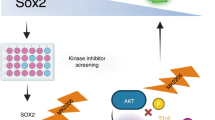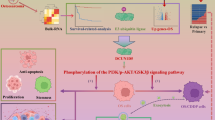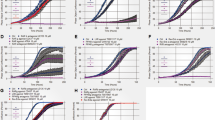Abstract
Chemoresistance is a major factor contributing to the poor prognosis of osteosarcoma. Increasing evidence underscores the pivotal role of enhanced tumor stemness in driving drug resistance. In this study we investigated the molecular mechanisms underlying the chemoresistance and stemness in osteosarcoma. Two cisplatin-resistant osteosarcoma cell line models (U2OS-DDPr and 143B-DDPr) were established by culturing parental U2OS and 143B cells with escalating cisplatin concentrations (250 ng/mL to 2.5 µg/mL) over a 6-month period. We found that the expression levels of suppressor of cytokine signaling 1 (SOCS1), an E3 ubiquitin ligase, were markedly downregulated in both chemo-resistant osteosarcoma cells and osteosarcoma tumor specimens, and the reduced expression in tumor specimens was correlated to poor prognosis in osteosarcoma patients. Silencing SOCS1 significantly reduced cisplatin sensitivity, enhanced spheroid formation capacity, and upregulated the expression of stem cell markers including SOX2, OCT4, and CD44. Conversely, restoring SOCS1 expression reversed these effects both in vitro and in vivo. Immunoprecipitation-mass spectrometry analysis revealed that SOCS1 bound to ACTN4 and suppressed its protein expression by promoting K63-linked ubiquitination, ultimately leading to proteasomal degradation. Specifically, the SH2 domain of SOCS1 interacted with the N-terminal region of ACTN4, with Lys66 of ACTN4 playing a critical role in facilitating this interaction and subsequent ubiquitination. In addition, the expression of ACTN4 was highly enriched in chemo-resistant tissues, and its overexpression was positively associated with advanced tumor staging. Importantly, ACTN4 functioned as an oncogene to promote cisplatin resistance and stemness in osteosarcoma. Furthermore, we found that wortmannin, an inhibitor of ACTN4, could markedly block the effect of SOCS1 silencing on osteosarcoma aggressiveness. In conclusion, SOCS1 deletion promotes stemness and chemoresistance in osteosarcoma by inhibiting ACTN4 ubiquitination and degradation, which offers promising therapeutic targets for potentiating chemosensitivity in osteosarcoma.
This is a preview of subscription content, access via your institution
Access options
Subscribe to this journal
Receive 12 print issues and online access
$259.00 per year
only $21.58 per issue
Buy this article
- Purchase on SpringerLink
- Instant access to full article PDF
Prices may be subject to local taxes which are calculated during checkout









Similar content being viewed by others
References
Beird HC, Bielack SS, Flanagan AM, Gill J, Heymann D, Janeway KA, et al. Osteosarcoma. Nat Rev Dis Prim. 2022;8:77.
Meltzer PS, Helman LJ. New horizons in the treatment of osteosarcoma. N Engl J Med. 2021;385:2066–76.
Gill J, Gorlick R. Advancing therapy for osteosarcoma. Nat Rev Clin Oncol. 2021;18:609–24.
Loh JJ, Ma S. Hallmarks of cancer stemness. Cell Stem Cell. 2024;31:617–39.
Nguyen LV, Vanner R, Dirks P, Eaves CJ. Cancer stem cells: an evolving concept. Nat Rev Cancer. 2012;12:133–43.
Pan G, Liu Y, Shang L, Zhou F, Yang S. EMT-associated microRNAs and their roles in cancer stemness and drug resistance. Cancer Commun. 2021;41:199–217.
Brown HK, Tellez-Gabriel M, Heymann D. Cancer stem cells in osteosarcoma. Cancer Lett. 2017;386:189–95.
Lin YH, Jewell BE, Gingold J, Lu L, Zhao R, Wang LL, et al. Osteosarcoma: molecular pathogenesis and iPSC modeling. Trends Mol Med. 2017;23:737–55.
Chen XP, Losman JA, Rothman P. SOCS proteins, regulators of intracellular signaling. Immunity. 2000;13:287–90.
Calvisi DF, Ladu S, Gorden A, Farina M, Conner EA, Lee JS, et al. Ubiquitous activation of Ras and Jak/Stat pathways in human HCC. Gastroenterology. 2006;130:1117–28.
Starr R, Willson TA, Viney EM, Murray LJ, Rayner JR, Jenkins BJ, et al. A family of cytokine-inducible inhibitors of signalling. Nature. 1997;387:917–21.
Palmer DC, Restifo NP. Suppressors of cytokine signaling (SOCS) in T cell differentiation, maturation, and function. Trends Immunol. 2009;30:592–602.
Baker BJ, Akhtar LN, Benveniste EN. SOCS1 and SOCS3 in the control of CNS immunity. Trends Immunol. 2009;30:392–400.
Zhang JG, Farley A, Nicholson SE, Willson TA, Zugaro LM, Simpson RJ, et al. The conserved SOCS box motif in suppressors of cytokine signaling binds to elongins B and C and may couple bound proteins to proteasomal degradation. Proc Natl Acad Sci USA. 1999;96:2071–6.
Zhuang J, Shen L, Li M, Sun J, Hao J, Li J, et al. Cancer-associated fibroblast-derived miR-146a-5p generates a niche that promotes bladder cancer stemness and chemoresistance. Cancer Res. 2023;83:1611–27.
Chen CY, Tsay W, Tang JL, Shen HL, Lin SW, Huang SY, et al. SOCS1 methylation in patients with newly diagnosed acute myeloid leukemia. Genes Chromosomes Cancer. 2003;37:300–5.
Galm O, Yoshikawa H, Esteller M, Osieka R, Herman JG. SOCS-1, a negative regulator of cytokine signaling, is frequently silenced by methylation in multiple myeloma. Blood. 2003;101:2784–8.
Ohkawa K. Suppressor of cytokine signaling 1, a newly proposed tumor suppressor gene associated with hepatocellular carcinoma. J Gastroenterol. 2004;39:598–600.
Rottapel R, Ilangumaran S, Neale C, La Rose J, Ho JM, Nguyen MH, et al. The tumor suppressor activity of SOCS-1. Oncogene. 2002;21:4351–62.
Kishimoto T, Kikutani H. Knocking the SOCS off a tumor suppressor. Nat Genet. 2001;28:4–5.
Calabrese V, Mallette FA, Deschenes-Simard X, Ramanathan S, Gagnon J, Moores A, et al. SOCS1 links cytokine signaling to p53 and senescence. Mol Cell. 2009;36:754–67.
Yeganeh M, Gui Y, Kandhi R, Bobbala D, Tobelaim WS, Saucier C, et al. Suppressor of cytokine signaling 1-dependent regulation of the expression and oncogenic functions of p21(CIP1/WAF1) in the liver. Oncogene. 2016;35:4200–11.
Li Z, Metze D, Nashan D, Muller-Tidow C, Serve HL, Poremba C, et al. Expression of SOCS-1, suppressor of cytokine signalling-1, in human melanoma. J Invest Dermatol. 2004;123:737–45.
Huang FJ, Steeg PS, Price JE, Chiu WT, Chou PC, Xie K, et al. Molecular basis for the critical role of suppressor of cytokine signaling-1 in melanoma brain metastasis. Cancer Res. 2008;68:9634–42.
Sjoblom B, Salmazo A, Djinovic-Carugo K. Alpha-actinin structure and regulation. Cell Mol Life Sci. 2008;65:2688–701.
Miyanaga A, Honda K, Tsuta K, Masuda M, Yamaguchi U, Fujii G, et al. Diagnostic and prognostic significance of the alternatively spliced ACTN4 variant in high-grade neuroendocrine pulmonary tumours. Ann Oncol. 2013;24:84–90.
Thomas DG, Robinson DN. The fifth sense: Mechanosensory regulation of alpha-actinin-4 and its relevance for cancer metastasis. Semin Cell Dev Biol. 2017;71:68–74.
Tentler D, Lomert E, Novitskaya K, Barlev NA. Role of ACTN4 in tumorigenesis, metastasis, and EMT. Cells. 2019;8:1427.
Honda K, Yamada T, Hayashida Y, Idogawa M, Sato S, Hasegawa F, et al. Actinin-4 increases cell motility and promotes lymph node metastasis of colorectal cancer. Gastroenterology. 2005;128:51–62.
An HT, Yoo S, Ko J. alpha-Actinin-4 induces the epithelial-to-mesenchymal transition and tumorigenesis via regulation of Snail expression and beta-catenin stabilization in cervical cancer. Oncogene. 2016;35:5893–904.
Yamamoto S, Tsuda H, Honda K, Onozato K, Takano M, Tamai S, et al. Actinin-4 gene amplification in ovarian cancer: a candidate oncogene associated with poor patient prognosis and tumor chemoresistance. Mod Pathol. 2009;22:499–507.
Jung J, Kim S, An HT, Ko J. alpha-Actinin-4 regulates cancer stem cell properties and chemoresistance in cervical cancer. Carcinogenesis. 2020;41:940–9.
Zhu M, Huang F, Sun H, Liu K, Chen Z, Yu B, et al. Characterization of ACTN4 as a novel antiviral target against SARS-CoV-2. Signal Transduct Target Ther. 2024;9:243.
Sharma S, Mayank AK, Nailwal H, Tripathi S, Patel JR, Bowzard JB, et al. Influenza A viral nucleoprotein interacts with cytoskeleton scaffolding protein alpha-actinin-4 for viral replication. FEBS J. 2014;281:2899–914.
Cheng M, Cao H, Yao P, Guan J, Wu P, Ji H, et al. PHF23 promotes NSCLC proliferation, metastasis, and chemoresistance via stabilization of ACTN4 and activation of the ERK pathway. Cell Death Dis. 2023;14:558.
Kile BT, Schulman BA, Alexander WS, Nicola NA, Martin HM, Hilton DJ. The SOCS box: a tale of destruction and degradation. Trends Biochem Sci. 2002;27:235–41.
Kamura T, Maenaka K, Kotoshiba S, Matsumoto M, Kohda D, Conaway RC, et al. VHL-box and SOCS-box domains determine binding specificity for Cul2-Rbx1 and Cul5-Rbx2 modules of ubiquitin ligases. Genes Dev. 2004;18:3055–65.
Anwar MA, El-Baba C, Elnaggar MH, Elkholy YO, Mottawea M, Johar D, et al. Novel therapeutic strategies for spinal osteosarcomas. Semin Cancer Biol. 2020;64:83–92.
Mu H, Zuo D, Chen J, Liu Z, Wang Z, Yang L, et al. Detection and surveillance of circulating tumor cells in osteosarcoma for predicting therapy response and prognosis. Cancer Biol Med. 2022;19:1397–409.
Kansara M, Teng MW, Smyth MJ, Thomas DM. Translational biology of osteosarcoma. Nat Rev Cancer. 2014;14:722–35.
Wei X, Feng J, Chen L, Zhang C, Liu Y, Zhang Y, et al. METTL3-mediated m6A modification of LINC00520 confers glycolysis and chemoresistance in osteosarcoma via suppressing ubiquitination of ENO1. Cancer Lett. 2024;611:217194.
Korholz J, Chen LS, Strauss T, Schuetz C, Dalpke AH. One gene to rule them all - clinical perspectives of a potent suppressor of cytokine signaling - SOCS1. Front Immunol. 2024;15:1385190.
Yoshikawa H, Matsubara K, Qian GS, Jackson P, Groopman JD, Manning JE, et al. SOCS-1, a negative regulator of the JAK/STAT pathway, is silenced by methylation in human hepatocellular carcinoma and shows growth-suppression activity. Nat Genet. 2001;28:29–35.
Beaurivage C, Champagne A, Tobelaim WS, Pomerleau V, Menendez A, Saucier C. SOCS1 in cancer: an oncogene and a tumor suppressor. Cytokine. 2016;82:87–94.
Lin L, Chen S, Wang H, Gao B, Kallakury B, Bhuvaneshwar K, et al. SPTBN1 inhibits inflammatory responses and hepatocarcinogenesis via the stabilization of SOCS1 and downregulation of p65 in hepatocellular carcinoma. Theranostics. 2021;11:4232–50.
Gong HL, Tao Y, Mao XZ, Song DY, You D, Ni JD. MicroRNA-29a suppresses the invasion and migration of osteosarcoma cells by regulating the SOCS1/NF-kappaB signaling pathway through negatively targeting DNMT3B. Int J Mol Med. 2019;44:1219–32.
Chen D, Bao C, Zhao F, Yu H, Zhong G, Xu L, et al. Exploring specific miRNA-mRNA axes with relationship to taxanes-resistance in breast cancer. Front Oncol. 2020;10:1397.
Ouyang S, Li H, Lou L, Huang Q, Zhang Z, Mo J, et al. Inhibition of STAT3-ferroptosis negative regulatory axis suppresses tumor growth and alleviates chemoresistance in gastric cancer. Redox Biol. 2022;52:102317.
Zitzmann K, Brand S, De Toni EN, Baehs S, Goke B, Meinecke J, et al. SOCS1 silencing enhances antitumor activity of type I IFNs by regulating apoptosis in neuroendocrine tumor cells. Cancer Res. 2007;67:5025–32.
Yang C, Li Y, Yang Y, Ni Q, Zhang Z, Chai Y, et al. Synthetic high-density lipoprotein-based nanomedicine to silence SOCS1 in tumor microenvironment and trigger antitumor immunity against glioma. Angew Chem Int Ed Engl. 2023;62:e202312603.
Sun H, Li H, Guan Y, Yuan Y, Xu C, Fu D, et al. BICC1 drives pancreatic cancer stemness and chemoresistance by facilitating tryptophan metabolism. Sci Adv. 2024;10:eadj8650.
Mu M, Zhang Q, Li J, Zhao C, Li X, Chen Z, et al. USP51 facilitates colorectal cancer stemness and chemoresistance by forming a positive feed-forward loop with HIF1A. Cell Death Differ. 2023;30:2393–407.
Perkins RS, Murray G, Suthon S, Davis L, Perkins NB 3rd, Fletcher L, et al. WNT5B drives osteosarcoma stemness, chemoresistance and metastasis. Clin Transl Med. 2024;14:e1670.
Lou L, Deng T, Yuan Q, Wang L, Wang Z, Li X. Targeted silencing of SOCS1 by DNMT1 promotes stemness of human liver cancer stem-like cells. Cancer Cell Int. 2024;24:206.
Liau NPD, Laktyushin A, Lucet IS, Murphy JM, Yao S, Whitlock E, et al. The molecular basis of JAK/STAT inhibition by SOCS1. Nat Commun. 2018;9:1558.
Miao M, Pan M, Chen X, Shen J, Zhang L, Feng X, et al. IL-13 facilitates ferroptotic death in asthmatic epithelial cells via SOCS1-mediated ubiquitinated degradation of SLC7A11. Redox Biol. 2024;71:103100.
Wymann MP, Bulgarelli-Leva G, Zvelebil MJ, Pirola L, Vanhaesebroeck B, Waterfield MD, et al. Wortmannin inactivates phosphoinositide 3-kinase by covalent modification of Lys-802, a residue involved in the phosphate transfer reaction. Mol Cell Biol. 1996;16:1722–33.
Walker EH, Pacold ME, Perisic O, Stephens L, Hawkins PT, Wymann MP, et al. Structural determinants of phosphoinositide 3-kinase inhibition by wortmannin, LY294002, quercetin, myricetin, and staurosporine. Mol Cell. 2000;6:909–19.
Brunn GJ, Williams J, Sabers C, Wiederrecht G, Lawrence JC Jr., Abraham RT. Direct inhibition of the signaling functions of the mammalian target of rapamycin by the phosphoinositide 3-kinase inhibitors, wortmannin and LY294002. EMBO J. 1996;15:5256–67.
Sarkaria JN, Tibbetts RS, Busby EC, Kennedy AP, Hill DE, Abraham RT. Inhibition of phosphoinositide 3-kinase related kinases by the radiosensitizing agent wortmannin. Cancer Res. 1998;58:4375–82.
Acknowledgements
We thank the public database for providing data for our research. This work was supported by the National Natural Science Foundation of China (82303076 and 82472905), National Key Laboratory of Druggability Evaluation and Systematic Translational Medicine (QZ23-10) and the Science & Technology Development Fund of Tianjin Education Commission for Higher Education (2022KJ225).
Author information
Authors and Affiliations
Contributions
XXH, GWW and XDZ conceptualized and designed the study. PL provided expert guidance in molecular docking and other experimental revisions during manuscript refinement. JYF, XFW and LC performed the major experiments. XFW, LC and HZY constructed the mouse model and performed the related assays. LC, YQL, and QQZ collected clinical information and performed clinical data analysis. YHL, JWW and YX performed bioinformatics and statistical analysis. JYF, XFW and LC designed and finalized the tables and figures. JYF and XFW wrote and revised the manuscript. All authors read and approved the manuscript.
Corresponding authors
Ethics declarations
Competing interests
The authors declare no competing interests.
Additional information
Publisher’s note Springer Nature remains neutral with regard to jurisdictional claims in published maps and institutional affiliations.
Supplementary information
Rights and permissions
Springer Nature or its licensor (e.g. a society or other partner) holds exclusive rights to this article under a publishing agreement with the author(s) or other rightsholder(s); author self-archiving of the accepted manuscript version of this article is solely governed by the terms of such publishing agreement and applicable law.
About this article
Cite this article
Feng, Jy., Wei, Xf., Chen, L. et al. SOCS1 depletion drives osteosarcoma stemness and chemoresistance by suppressing ACTN4 degradation. Acta Pharmacol Sin (2025). https://doi.org/10.1038/s41401-025-01650-3
Received:
Revised:
Accepted:
Published:
DOI: https://doi.org/10.1038/s41401-025-01650-3



